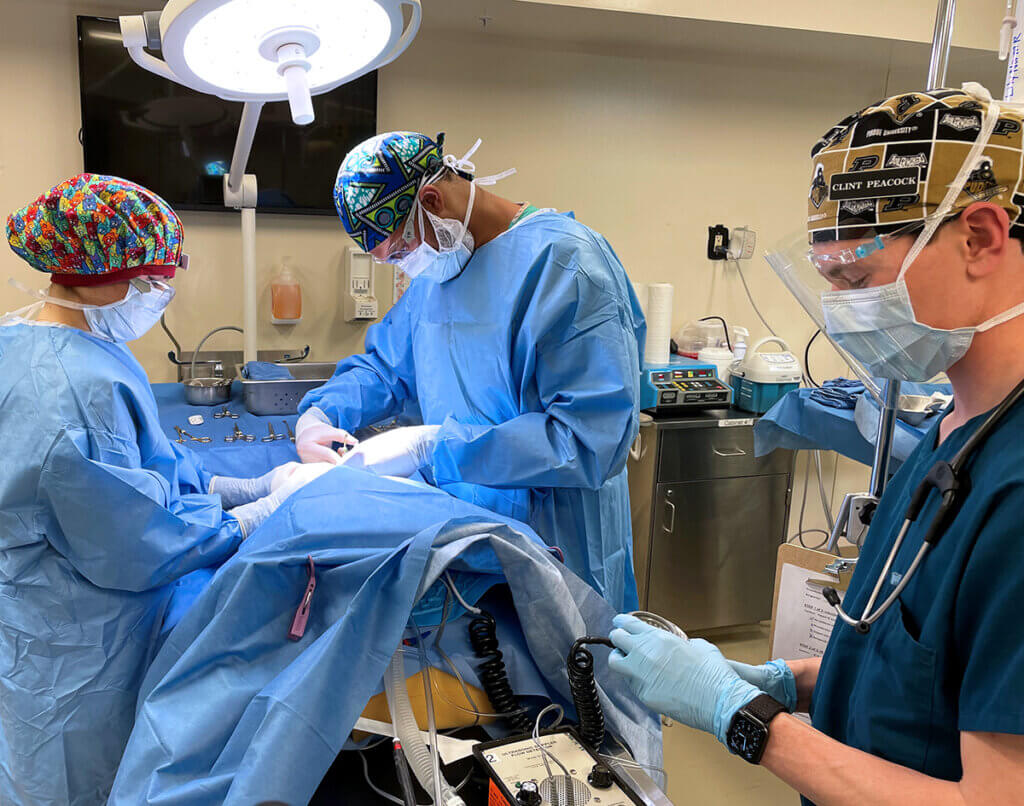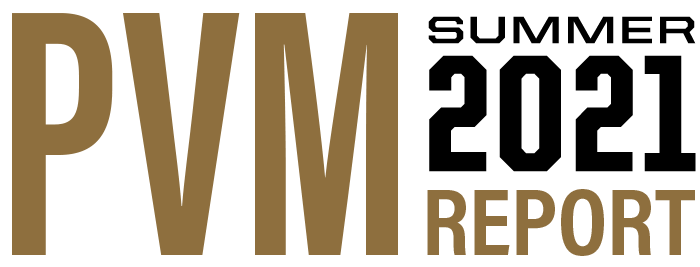How the College of Veterinary Medicine’s Faculty and Staff Delivered Hands-on Education in the Face of a Pandemic to the Next Generation of Veterinarians and Veterinary Nurses
Let’s face it. Learning surgical skills is a hands-on experience. At the Purdue University College of Veterinary Medicine, the curriculum for students destined to be future veterinarians and veterinary nurses all culminates in pivotal clinical education, when all the material learned from lectures, labs, and lessons coalesce into true know-how through the crucible of actually practicing medicine for real.
In that light, the biggest threat posed by the pandemic to the College of Veterinary Medicine was the risk of having to forego hands-on clinical instruction. For reasons well known now, the idea of safely carrying out face-to-face, hands-on teaching seemed almost impossible as the pandemic unfolded in 2020. But Boilermakers aren’t intimidated by big challenges. Boilermakers persistently pursue answers and solutions to make what seemed impossible possible.
So, as Purdue University crafted the Protect Purdue Pledge and planned for a responsible and safe return to in-person classes for the fall semester, the College of Veterinary Medicine’s faculty and staff applied the Protect Purdue requirements to the Doctor of Veterinary Medicine and Veterinary Nursing programs. That meant not only providing for in-person classroom lectures with appropriate social distancing, frequent screening, sanitizing, and mask wearing, but also preparing for in-person, hands-on clinical training.

A vital part of the hands-on instruction for veterinary students involves learning basic surgical skills and how to perform simple surgical procedures. In the Small Animal Surgery Laboratory course during the third year of the four-year DVM curriculum, students actually are able to learn to perform surgeries to neuter cats and dogs that are getting ready for adoption at local animal shelters. In the spring, students do the work under the direct supervision of their instructors, who include Dr. Sarah Malek, assistant professor of small animal surgery; Dr. Tomo Inoue, anesthesiology lecturer; and three dedicated veterinary nurses – anesthesiology technologist Amy Huffman, small animal surgery technologist Cass Simmons, and teaching animal protocol technologist Sara Schroeder. The course also benefits from additional instructors across the Small Animal Hospital, including faculty, residents and interns, and veterinary nurses, who support the teaching needs of these laboratory sessions.
As Instructor of Record for the spring semester course, Dr. Malek knew from first-hand experience how these labs expand the students’ skill set and provide an important service to area animal shelters while also giving surgery residents and interns exposure to what’s involved in assuming a teaching role. “We’ve worked to enhance the quality of teaching and course material in these labs and to improve the efficiency of the labs to better balance the amount of time the students have to spend in the laboratory while also maximizing learning opportunities,” Dr. Malek said. She noted that the value of the course is widely recognized and it has benefitted from various donations made by individuals and companies, including gifts of needed equipment and supplies.
Yet all of the benefits of these labs were at risk of being lost as the college grappled with the impact of the pandemic. Only so much could be done virtually to try to replicate the experiential learning the students gain from the hands-on surgical instruction. Perseverance by the educational team, however, won out in the end, ensuring that students could continue to learn regardless of the circumstances. “With the challenges of the pandemic during the past year, when we had to shut down the in-person student surgery labs during the spring of 2020, we still were able to conduct portions of the labs virtually,” Dr. Malek recalls. “We created quizzes and assignments, including some that were video-based that enabled our students to practice their knowledge of surgical skills in a virtual environment.”
Then this year, with Protect Purdue protocols in place, Dr. Malek said, “We were able to conduct all the labs on schedule with appropriate protective measures that included wearing both masks and face shields to ensure the health and safety of students, staff, and faculty.” As a result, all of the third-year students received the benefits of performing hands-on surgeries, and no one contracted COVID-19 through their participation in these surgery lab sessions.
The animals benefitted, too, as needed surgeries to neuter them were performed for more than 150 shelter dogs and cats awaiting adoption in the spring alone. “Everyone rallied to make it work,” Dr. Malek said. “Even with the challenges created by the pandemic, we made our best effort to conduct this course with the vision of creating practice-ready veterinarians with basic surgical skills, while providing a needed service for partnering animal shelters.”
Dr. Kathy Salisbury, associate dean for academic affairs, said student surgery is a microcosm of what happened across the college and throughout the curriculum. “Staff and faculty really pulled out all the stops to provide for the best possible hands-on learning opportunities for our students in both the DVM and Veterinary Nursing programs, while ensuring the health and safety of everyone by carefully following Protect Purdue protocols,” Dr. Salisbury said.
With a total of nearly 340 veterinary students and about 100 veterinary nursing students enrolled on the West Lafayette campus, the goal of ensuring that everyone could safely participate in the in-person classes, labs, and clinics involved formidable challenges. But, Dr. Salisbury said faculty and staff worked diligently to make that happen. “Our students, faculty, and staff showed a remarkable commitment to following the necessary safety protocols from frequent hand-washing to wearing masks and face shields. As a result the students received the hands-on learning, whether in labs or clinics, that is so necessary to mastering the skills needed in private practice, and at the same time, we avoided any COVID-19 transmission within the college.”
Dr. Salisbury said extra safety precautions, like wearing both masks and face shields, were required in multiple courses that involved in-person laboratory instruction, such as the veterinary skills and competencies courses, large animal surgery laboratories, theriogenology laboratories, and nearly 20 other pre-clinical courses, in addition to the numerous hospital clinical rotations for fourth-year students.
The Veterinary Nursing program faced challenges just as daunting as those in the DVM program, as the instructional staff ensured that the students could gain valuable hands-on experience in a way that protected their health and safety. “We had 16 courses and labs that necessitated special precautions to ensure that faculty, staff, and students were suitably protected from the COVID-19 virus,” said Dr. Chad Brown, program director. “It took real teamwork, and in that sense the pandemic actually provided an opportunity to model the way in which our veterinary nursing students will need to work well as members of veterinary medical teams when they graduate and enter private practice.”
Similar challenges were faced in the Purdue University Veterinary Hospital where the DVM and Veterinary Nursing students participated in clinical rotations to complete their education. “We are so proud of how the clinicians and staff shouldered the heavy load of providing the clinical experience and instruction that our students need to be practice-ready veterinarians and veterinary nurses when they graduate,” Dr. Salisbury said. “Not only did they have to carefully follow the Protect Purdue protocols, they did so even as the hospital saw a dramatic increase in caseload during the year – an increase in excess of 20% compared to the preceding year. It has been a remarkable year that really revealed just how remarkable our faculty and staff members are.”

